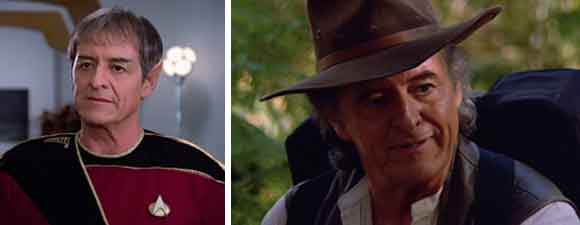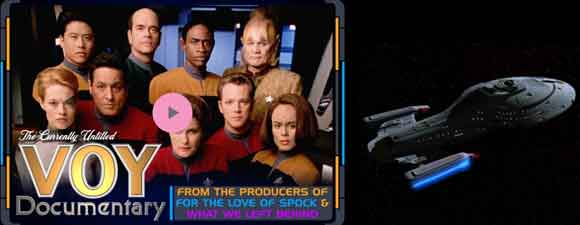Retro Review: Projections
7 min read
Projections Banner
The Doctor is told that he is Louis Zimmerman, creator of the EMH, and has become trapped in a holodeck simulation he was running.
Plot Summary: In the midst of a ship-wide emergency that has caused most of the crew to abandon Voyager, Torres uses a new holo-emitter to send the Doctor to the bridge, where Janeway has been critically injured. The Doctor treats her injuries and learns that a Kazon attack caused massive damage. When Neelix summons help to subdue a Kazon who has boarded the ship, the Doctor transfers to the mess hall to assist, then returns to sickbay. There, he discovers that he has a heart rate and life signs, whereas Torres, the captain, and everyone else reads as unreal. The computer tells him that he is Louis Zimmerman, creator of the EMH. When Janeway suggests rebooting the holographic system, since the new emitters have apparently caused the Doctor to malfunction, she vanishes along with everyone remaining on the ship. Lieutenant Reginald Barclay appears and introduces himself as a hologram – a representation of one of the programmers who created the EMH. Barclay explains that Zimmerman was running an experimental program on a holodeck on Jupiter Station when a radiation surge damaged both the holodeck and Zimmerman’s brain. If Zimmerman does not shut down the program, he will die. Because the Doctor is skeptical, Barclay resets the Voyager simulation, making the Doctor relive his first hours on board after the Caretaker’s attack. Barclay also brings in Kes, whom he claims is Zimmerman’s wife. She and Barclay attempt to persuade the Doctor to destroy Voyager’s warp core in order to end the holographic ship simulation and allow Zimmerman to leave the holodeck on Jupiter Station. But Chakotay appears, telling the Doctor that he is in fact an emergency medical hologram on Voyager, who was running a program on the holodeck when a radiation surge trapped him there. If the Doctor destroys the holographic scenario as Barclay demands, he will cease to exist. Refusing Barclay and Kes’s version of reality, the Doctor finds himself on an empty holodeck with the real Janeway, who explains that the crew was able to repair his program. Back in sickbay, Kes teases him about how he can never be sure whether he’s only the sum of his programming or something more.
Analysis: I have a tendency to believe that I’ve seen all the early Voyager episodes many times, but that’s not really true; I’ve seen episodes I love, like “Remember” and “Resolutions,” many times, but there are some episodes I’ve only watched once. I didn’t recall anything about “Projections” except that it focused on the Doctor, so I assumed it either wasn’t very good or just didn’t interest me, and rather than risk biasing myself, I didn’t read my old review of it before watching it earlier this week. As it happens, I really enjoyed it, and when I read my original review, I always thought it was really well done, so I have no idea why I let myself overlook the episode for all these years. The story does focus on the Doctor to such an extent that we scarcely see the rest of the crew except as projections of themselves, so I suppose that someone who doesn’t appreciate Robert Picardo’s mannerisms might not like it, but I can’t imagine how anyone couldn’t love Picardo, the most consistent performer on Voyager throughout its seven year run (Ethan Phillips also never seems to give less than a hundred percent, but Neelix’s characterization is less consistent than the Doctor’s, particularly in these early episodes when he’s used as forced comic relief). There’s scarcely a shot in “Projections” in which Picardo does not appear and he’s perfect in all of them. It’s particularly fascinating to see him in the “Caretaker” flashback showing how much the Doctor has grown from his initial stuffy, snarky persona. And it makes total sense that Reg Barclay is in part responsible for the awkward personality he initially had, though it also makes sense that Barclay – the great optimist from Picard’s Enterprise about blurring the lines between real and holographic life – would have insisted on the possibility that an EMH or any other permanent interactive hologram could become far more than the function for which it was designed. Chakotay tells the Doctor that what he’s made of matters less than what he believes, and the Doctor never really wavers in his belief that he’s a hologram because he already knows how much more he can become than the purpose for which he’s been told he exists.
It’s no accident that Star Trek is at its best developing characters who struggle with learning what it means to be human. No matter how much lip service is given to the intelligence of Spock or Data, we’re shown over and over that logic is not enough – that even Qs and V’gers need to experience something more than the accumulation of knowledge, that the most self-sufficient creatures in the universe seek companionship and, if not spirituality, then some sense of grander purpose. If this tendency demonstrates a pro-human bias in what’s supposed to be a vastly diverse universe of species, it also makes such characters relatable, not just Spock and Data but Odo, the Doctor, Seven of Nine, “God” from The Final Frontier. A permanent holographic character is a brilliant idea, offering some of the same advantages as an android with different limitations. If the Doctor is more prone to express mature frustration rather than Data’s childlike wonder, it’s because Zimmerman and Barclay designed him that way. They’ve also saddled the Doctor with some strange restrictions, like making it necessary for him to put commands into the computer in order to get information rather than allowing his program to access other programs directly. True, the EMH was created to operate only within the confines of Sickbay – another limitation on a ship where injuries occur all over, though we’re led to believe that Starfleet isn’t even close to the sort of mobile emitter technology that the Doctor later acquires, though the fictional Torres and Janeway of this episode suggest that it’s being investigated. Barclay, at least, knows the dangers of holographic reality all too well, both how seductive it can be to those who use it and how much power can be channeled through it. On several occasions, Next Gen aliens used the holodeck to reshape reality for Enterprise crewmembers, and when asked to create a holographic character with the intelligence to outwit an android, it created Moriarty, a sentient adversary who could not only make his influence felt all over the ship, but could reject his initial nefarious purpose in favor of other pursuits.
I doubt Barclay was worried about creating an EMH that would decide to refashion itself as a villain, despite director Jonathan Frakes’ use of distorted images and menacing music to disrupt viewer trust in the character. But it’s strange that Barclay (who hilariously claims he modeled the annoying Tom Paris on his cousin) didn’t give sickbay’s backup medical officer the programming to understand pain. It’s something of which the Doctor is apparently capable, as he learns in his holodeck program, and will now keep in mind as he treats patients, which ought to make him a more empathetic doctor. On a mission like Voyager’s, the temptations of the holodeck, where a crewmember can summon absent lovers or recreate home, must be particularly dangerous, like the wish-fulfilling Mirror of Erised from Harry Potter. No wonder Paris chose an old-world setting for Sandrine’s…home, yet not too much so. Nonetheless, if the crew suffers from the desire to keep home alive in the Delta Quadrant, the Doctor suffers from the reverse, knowing that if the ship does get back to the Alpha Quadrant, the only “home” he has ever known will change radically as crewmembers leave and he faces deactivation, possibly forever. He’s seen that people switch him off and reprogram him to fit their whims, and he’s expressed to Kes the concern that he could be left permanently active yet completely alone if the crew abandons ship. Perhaps his sarcasm allows him healthy emotional distance from these crewmates, even though he is closest to the one who will live less than a decade no matter what he does. Given the choice to become a real boy, what will this Pinocchio choose – a life that may be brief yet contain pleasures he never thought he’d have? Or the reality with which he has become familiar, with a solid sense of self balancing its limitations? Unlike Data, the Doctor doesn’t have the choice to switch off an emotion chip. He gains emotional maturity like every human by experiencing loss, as with Freya on the holodeck, and love, like his platonic yet nurturing friendship with Kes. That Picardo can allow us to witness this slow evolution with humor and pathos would be a reason to watch Voyager even if that were the show’s only pleasure.







Robert Picardo is wonderful, always such a pleasure to watch. It amuses me that the producers of Voyager cast a lot of beautiful people for the non-holographic crew members, yet the cast member who’s the most fun to watch is the balding, middle-aged man. Great acting beats a pretty face any day!